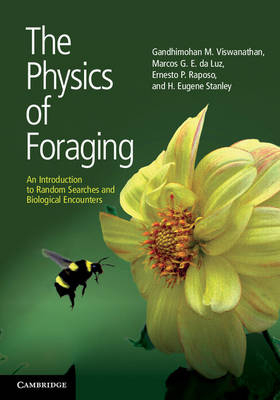
The Physics of Foraging
Cambridge University Press (Verlag)
978-1-107-00679-9 (ISBN)
Do the movements of animals, including humans, follow patterns that can be described quantitatively by simple laws of motion? If so, then why? These questions have attracted the attention of scientists in many disciplines, and stimulated debates ranging from ecological matters to queries such as 'how can there be free will if one follows a law of motion?' This is the first book on this rapidly evolving subject, introducing random searches and foraging in a way that can be understood by readers without a previous background on the subject. It reviews theory as well as experiment, addresses open problems and perspectives, and discusses applications ranging from the colonization of Madagascar by Austronesians to the diffusion of genetically modified crops. The book will interest physicists working in the field of anomalous diffusion and movement ecology as well as ecologists already familiar with the concepts and methods of statistical physics.
Gandhimohan M. Viswanathan is Professor of Physics at the Universidade Federal do Rio Grande do Norte. Previously, he was Associate Professor at the Instituto de Física, Universidade Federal de Alagoas, where he spent over a decade investigating the complex phenomenology seen in physical, biological and economic systems. Marcos G. E. da Luz is an Associate Professor in the Departamento de Física, Universidade Federal do Paraná. He works with both numerical and analytical methods in disorder, complexity and non-linearity in classical and quantum systems and with theoretical models in ecology. Ernesto P. Raposo is an Associate Professor in the Laboratório de Física Teórica e Computacional, Departamento de Física, Universidade Federal de Pernambuco. His current research interests include statistical physics of random searches and the foraging problem, disordered antiferromagnets, and quantum field theory of quasi-unidimensional magnetic polymer chains. H. Eugene Stanley is a University Professor and Director of the Center for Polymer Studies, Boston University, Professor of Physics, Chemistry and Biomedical Engineering, and Professor of Physiology at Boston University School of Medicine. A pioneer in interdisciplinary science, he has won the Boltzmann Medal and numerous other awards for his contributions.
Part I. Introduction: Movement: 1. Empirical motivation for studying movement; 2. Statistical physics of biological motion; 3. Random walks and Lévy flights; 4. Wandering albatrosses; Part II. Experimental Findings: 5. Early studies; 6. Evidence of anomalous diffusion; 7. Human dispersal; 8. How strong is the evidence?; Part III. Theory of Foraging: 9. Optimizing encounter rates; 10. Lévy flight foraging; 11. Other search models; Part IV. Finale: A Broader Context: 12. Superdiffusive random searches; 13. Adaptational versus emergent superdiffusion; 14. Perspectives and open problems; Appendices; References; Index.
| Erscheint lt. Verlag | 2.6.2011 |
|---|---|
| Zusatzinfo | 4 Halftones, black and white; 40 Line drawings, black and white |
| Verlagsort | Cambridge |
| Sprache | englisch |
| Maße | 180 x 255 mm |
| Gewicht | 510 g |
| Themenwelt | Naturwissenschaften ► Biologie ► Zoologie |
| Naturwissenschaften ► Physik / Astronomie ► Angewandte Physik | |
| Naturwissenschaften ► Physik / Astronomie ► Thermodynamik | |
| ISBN-10 | 1-107-00679-1 / 1107006791 |
| ISBN-13 | 978-1-107-00679-9 / 9781107006799 |
| Zustand | Neuware |
| Haben Sie eine Frage zum Produkt? |
aus dem Bereich


